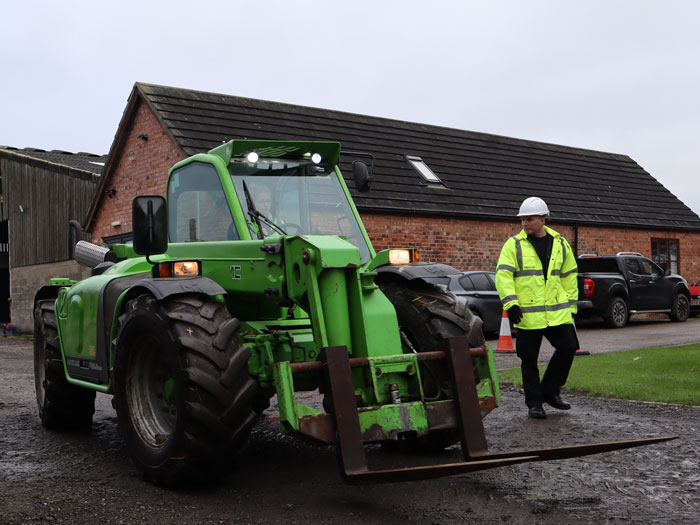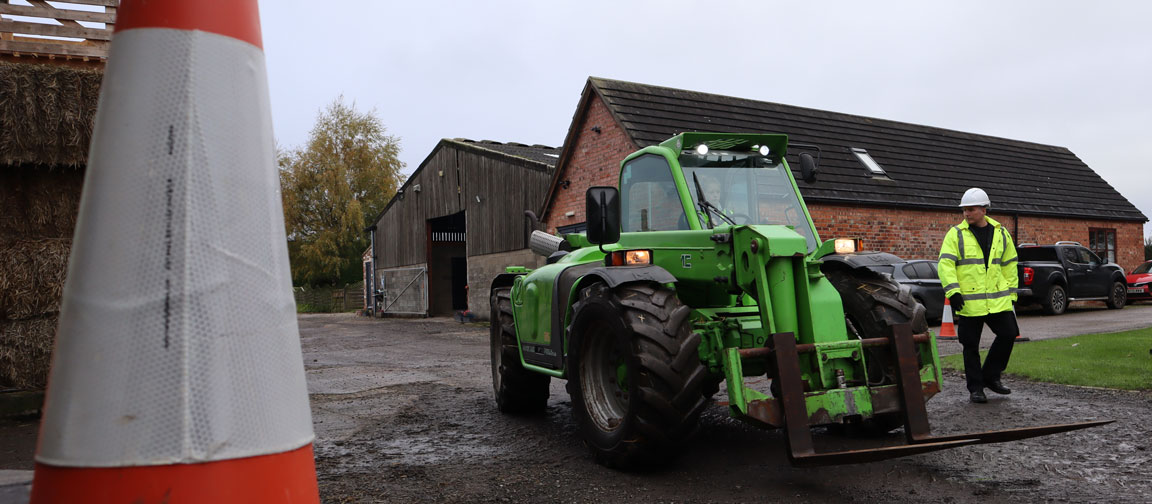Steps to reduce the risk of a farm accident
19 March: Site maintenance at 16:00 GMT today - if you are logged in at this time you will be logged out briefly.

Steps to reduce the risk of a farm accident
Steps to reduce the risk of a farm accident

Farming involves making quick decisions while taking on different roles like mechanic, operator, and agronomist.
Protecting your business and production from risks is important. This includes dealing with unpredictable markets, changing regulations, and bad weather that can all impact your profits. These risks are managed in the open. But how are you managing risks posed to you physically?
At Farmers Weekly Transition Live on 9 May 2024, Cambridgeshire, there was an announcement for a Go Fund Me account set up to support a farmer who suffered life changing injuries earlier in the year. Sadly, he was far from the only farmer to be directly impacted by bodily harm so far in 2024.
Perhaps you can think of farmers you know who have been injured at work...
In 2023, 32 people died in farm accidents, making up over 40% of workplace deaths in the UK. Statistics like these caused David Exwood, NFU Deputy President, to say: “The time for change is now.” It’s figures like this which also drove the NFU to launch its ‘Take 5 to Stay Alive’ campaign.
It’s no secret that agriculture is known for having the poorest safety record of any British industry – which sounds unfair on farmers but makes sense considering how often you work alone remotely, surrounded by active machinery among other risks.
The constant burden of time pressure can also lead to rushed decisions. Can you think of a time recently when you put your business ahead of your personal safety?
This initial article discusses the risks associated with working on farms, particularly those involved with farm machinery. How can you mitigate risk, and where can you go for additional resources and support?
Health and safety culture
Alongside machinery, other common causes of fatalities include livestock trampling, being struck by moving objects, including vehicles, and falling from height.
Arguably, there are risks inherent to working on farms—working alone remotely with machinery is an almost daily occurrence. These can’t be avoided. But while we can't eliminate all risks, we can mitigate some.
Taking yourself or your wider team on a path towards increased awareness is the first step to making your farm a healthier and safer place to work. We believe a proactive approach to risk reduction is key. Don’t wait until the need for change directly arises, as by then, it’s likely too late.
Take 5 to Stay Alive
The NFU's ‘Take 5 to Stay Alive’ campaign encourages farmers and growers to take a five-minute pause to think about the task in front of them.
Regardless of the task, taking a moment for a quick risk assessment can greatly help farmers and growers plan their next task. Doing this can help them avoid risk and ensure they have any relevant personal protective equipment before they start.
Adopting this approach can also be a great step in maintaining a good culture of health and safety on-farm too. Watch the NFU's video below for an introduction to the campaign.
The risks posed by farm machinery
Starting with tractors - the most common year-round vehicle used on farms and often coupled with machinery. Tractors are large, powerful and have a high centre of gravity.
Despite the good visibility provided by the 360 windows of most tractors, straight impact injuries are still an occurrence. So always take a moment to ensure those around you are clear before pulling away. It may sound trivial, but these steps are vital as moving or overturning vehicles have been involved in around 40% of all farm fatalities over the last five years.
Often, the operator is most at risk of personal injury with machinery work. If the tractor rolls, they may become dislodged in the cab and sustain injuries. But often, they’ll oversee the machinery they’re towing and this poses its own risks.
When driving a tractor, it's important to follow workplace rules, do maintenance checks, and check visibility before starting.
Handling the power take-off (PTO)
The PTO shaft is just as dangerous as the tractor itself. Revolving at speed and including its own gearbox and couplings, the PTO poses real threats of entanglement.
Entanglement happens when loose clothing, such as overalls or body parts, gets stuck in a moving machine. This can cause serious injuries that may be fatal, especially if you're working alone.
When working with tractors, always remember to disengage the PTO before stepping down from the cab. Only step down after following the 'SAFE STOP' procedure. This means handbrake on, gears in neutral, engine off and key removed.
Proper maintenance and careful operation significantly reduce risks on the farm. However, farmers may neglect these tasks when they're tired or rushed during busy seasons. The above video, made by the NFU, highlights the dangers of working with PTO shafts and important steps you can easily take to work with them safely.
You can quickly share best practice on working with PTOs by holding a Toolbox Talk on the subject: We're bringing information together on a host of subjects to help you quickly upskill your team with these handy, simple to use guides so you can ensure everyone on-farm is following the same process with important tasks.
Find out how you can use Toolbox Talks to develop your farm team's skills.
Other machinery risks
Many risks exist on the farm. These include being trapped by trailing machinery, being struck by sprayer booms, especially if the tractor turns as the far end of the boom builds force, and contact with bladed machinery, such as chainsaws.
Farmers and growers can lower the risk of accidents by following PUWER (Provision and Use of Work Equipment Regulations 1998) and other strict rules.
To find out and learn more about these requirements in an informative and interactive way, consider completing our Farming with Safety in Mind Learning Path.
Using a quad bike safely
All Terrain Vehicles (ATVs) and quad bikes are often used on farms for various tasks. One common risk is the operator getting thrown off or trapped, leading to impact injuries. As such, anyone using a quad bike should always wear a helmet and handle the vehicle with care. An ATV is similar in weight and power to an adult horse, so riders should treat it with a similar level of caution and respect.
Always follow road speed laws and never carry children as passengers on an ATV.
Put simply, safety protocols are there for a reason and are proven to prevent vehicle-related accidents.
Five quick tips to improve vehicle safety on-farm
- Isolate tractor engines when you’re not in the driving seat
- Take 5 to Stay Alive
- Avoid wearing loose clothing that could become entangled when working with PTOs
- Ensure maintenance and pre-vehicle checks are complete
- Promote a safety culture on your farm
Take TIAH’s Essential Skills, Farm Vehicle Safety module to learn more and improve your knowledge about handling farm vehicles safely.
Practical steps to prevent moving object collisions
Being struck by a moving or falling object is one of the top causes of injury on farms. Moving objects can include hay bales, bags of seed or fertiliser, trees, tools or objects stored at height.
Again, in addition to health and safety laws, you need to be mindful of the laws of physics and motion when embarking on a task involving moving objects. Static situations can rapidly turn active when an object is moved from height or transported from A to B.
Risk planning and assessment are essential here and tie into the ‘Take 5 to Stay Alive’ campaign mentioned earlier. Instead of rushing, take a moment to think about the possible outcomes of your actions. This is especially important for your safety and the safety of those around you.
Emergency preparedness is also advisable. If something went wrong on your farm today, how quickly could you access a first aid kit? Would you know what’s in it?
To gain a full understanding of the range of situations where objects could fall and cause injury, plus the ‘five step process for controlling the risk of falling objects’ members can take our Essential Skills module on Avoiding Impacts.
Quick tips for avoiding collisions
Checking your vehicle before driving is important to ensure it's safe and will work properly when needed. Operators should ensure mirrors are clean, and visibility is good as part of these checks.
But even if you have full confidence in your machine’s brakes and your mirrors are clean and well set, it is important to always be mindful of changing road surfaces, gradients and those operating within your vicinity.
Where possible, use spotters when necessary, such as when reversing or approaching blind corners, entrances or exits.
Lastly, it's best practice to establish traffic rules and signage on your farm site. Doing so helps avoid confusion when operators move machines in each other’s vicinity.
Make your farm a safer place
Ensuring health and safety practices are maintained on the farm is not just a legal obligation but a moral imperative. The risks associated with farm machinery are significant and demand careful attention and proactive measures to mitigate them.
By understanding the inherent dangers of machinery operation, implementing simple yet robust safety protocols, and investing in training and education, you can prioritise the wellbeing of yourself and your team members.
To reduce the risk of accidents on the farm, it's important to create a culture of safety. This can be done by taking precautions such as turning off engines and checking equipment regularly. Prioritizing safety greatly lowers the chances of farm accidents occurring and improves your safety record.
Moreover, accessing resources and support, such as our Essential Skills modules, can further empower you to make informed decisions and implement effective safety measures.
Ultimately, the goal is clear: to create a farm environment where everyone works safely and gets home safely. By embracing a proactive approach to health and safety and leveraging available resources and expertise, you can safeguard your livelihood and your most valuable asset—your health and wellbeing.
Let's commit to making health and safety a top priority on every farm, today and for generations to come, and start lowering the statistics we began with.